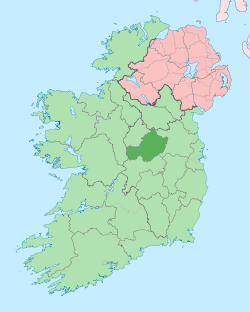Castletown Geoghegan
| Castletown Geoghegan Baile Chaisleáin na nGeochagán | |
|---|---|
| Town | |
|
Castletown in winter | |
 Castletown Geoghegan Location in Ireland | |
| Coordinates: 53°26′49″N 7°29′20″W / 53.447°N 7.489°WCoordinates: 53°26′49″N 7°29′20″W / 53.447°N 7.489°W | |
| Country | Ireland |
| Province | Leinster |
| County | County Westmeath |
| Elevation | 95 m (312 ft) |
| Population (2006)[1] | |
| • Total | 693 |
| Time zone | WET (UTC+0) |
| • Summer (DST) | IST (WEST) (UTC-1) |
| Irish Grid Reference | N337442 |
Castletown Geoghegan (Irish: Baile Chaisleáin Mag Eochagán)[2] in County Westmeath, Ireland, lies south west of Lough Ennell near the county town of Mullingar. Castletown was the seat of the Geoghegan family of the medieval Barony of Moycashel, County Westmeath. The family were descendants of the Southern Ui Neill. They were major landholders in south Westmeath prior to the Cromwellian invasion, the Down Survey and ensuing Plantations that followed that and the later War of the Three Kingdoms. They lost considerable portion their estates to Gustavus Lambart (later created Earl of Cavan) through confiscation prior to the publication of the Down Survey. The evident productivity of the rich grazing being so self evident he procured it early in the piece.
The Restoration resettlement Acts of the late 17th century favored the retention by some of the newly esconsced Cromwellian Adventurers and Undertakers and some to their traditional owners. Consequently, only relative smallholdings of the rich grazing lake land was restored to the Geoghegans. It didn't help that case for a greater proportion of restoration that many of his fellow Chiefs of the "Irish of Meath" refused to sign the mandatory pledges and undertakings to the King, Parliament and the established church. Political acumen was not their strong suit.
Lilliput, on the shores of Lough Ennel is in Dysart, approximately 5k from Castletown Geoghegan. Nearby Middleton Park House, a magnificent 19th century Georgian house and estate, is now open to the general public.
History
The Mac Eochagáin family are descended from Fiacha, son of Niall Naoi Noigíallach. Niall is reputed to have captured and enslaved the teenage Magnus Succetus - who later returned to preach Christianity as Patricius - in a raid on the Cumbrian or Welsh coast. The descendants of Niall's son Fiacha (Fiachu Fiachrach) were collectively known as Cenel Fhiachaigh, of the southern Ui Neill (later anglicised as Kenaleagh and Kindalane).
In the general political reform following the Tudor Conquest, the somewhat reduced medieval barony was subject to the 'Surrender and Regrant' process and the adroit Geoghegan family Chief Kedagh was accorded the title of 'Captain' Geoghegan in the reign of Queen Elizabeth I. He resided in the principal Geoghegan castle which was located in the village at this time. The original motte and bailey is extant close by.
The Geoghegan family led a group of local Gaelic chieftains in a notable and powerful long term alliance. The 'Irish of Meath' included the O'Melaghlin (McLaughlin), O'Maolmhuidhe (Molloy), Kearney, Fox, Dalton and Brennan families. These native septs all suffered heavy property confiscation after the Confederate and Williamite Wars. They are prominent in the Annals of Clonmacnoise, a notable collection of historical records. Many received offers of Surrender and Regrant deals after the Restoration, but some rejected the terms. Recalcitrants were reluctant to adhere to the terms of oaths of fealty required. The Annals collection was translated from the original Irish into Elizabethan English by Conall Geoghegan, a 16th-century Franciscan monk.
Abbe James Mac Geoghegan, born in nearby Uisneach, wrote his celebrated Mac Geoghegan's History of Ireland at Chartres in France in the 18th century. This history became Eamon De Valera's desk companion for his political life.
The surrounding territories were held by the Tyrrells of Fartullagh, the Dillon's of Drumrany (which lay to the west between Moate and Athlone). The Nugents of Delvin, later Lords Delvin and Marquess of Westmeath and the Tuites of Sonagh were to the east.
Sport
Among the most popular local sports are G.A.A. football and hurling. The Castletown Geoghegan Hurling Club sports the black and amber stripe. It was introduced by a Kilkenny railway employee, and became a tradition here. The club holds 12 senior hurling titles, 1923, 1956, 1957, 1958, 1960, 1964, 1979, 1982, 1986, 1990, 2004 and 2013. The club has a very strong junior component. It achieved two National titles at under the 14 level in 2007 and 2010 The club crest depicts the ruins of a castle on the shores of Lough Ennel with the sun rising in the background.
The 1946 Epsom Derby winner, Airborne was bred near the village in 1943.[3] Oscar Time was trained locally by Martin Lynch, the successful horse trainer and jockey.
-

Castletown Geoghegan sign
-
Castletown Geoghegan & Lough Ennell
-
Castletown Geoghegan GAA colours
See also
- List of towns and villages in Ireland
- Dermot Farrell
- Nomenclature The historic and literary term as Gaeilge is well established as Baile Chaisleain Mag Eochagain. The name applied by Mr. O'Cuiv's Commission is neither traditional Gaeilge or family origin approved.
References
- ↑ "Census 2006 – Volume 1 – Population Classified by Area" (PDF). Central Statistics Office Census 2006 Reports. Central Statistics Office Ireland. April 2007. Retrieved 2011-06-25.
- ↑ "Baile Chaisleáin na nGeochagán/Castletown Geoghegan". Placenames Database of Ireland. Government of Ireland. Retrieved 25 June 2011.
- ↑ Armytage, Marcus (2011-03-31). "Oscar Time primed for his chance in the Grand National spotlight". London: Telegraph. Retrieved 2011-11-12.
External links
- Geoghegan Clan
- Field Study of the midlands
- Niall of the Nine Hostages
- Westmeath County Council information source
| ||||||||||||||||||||||||||


